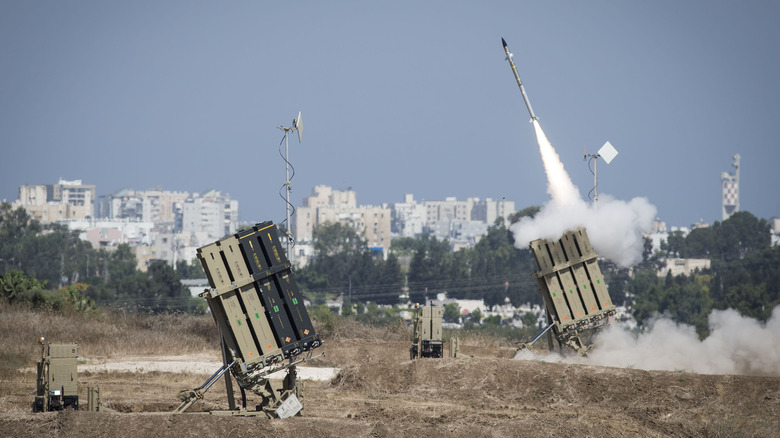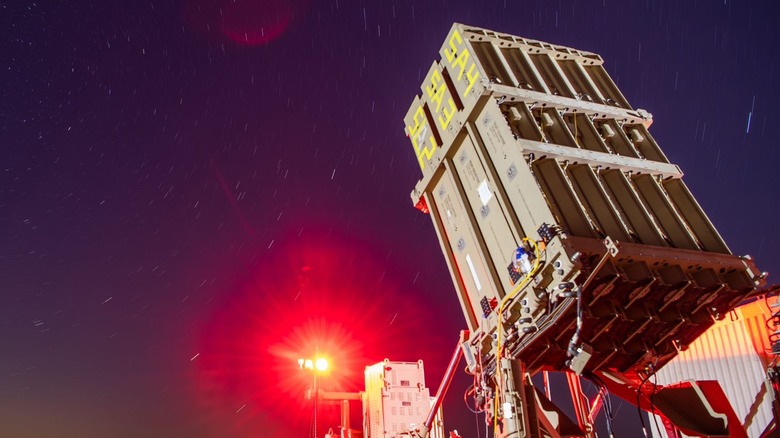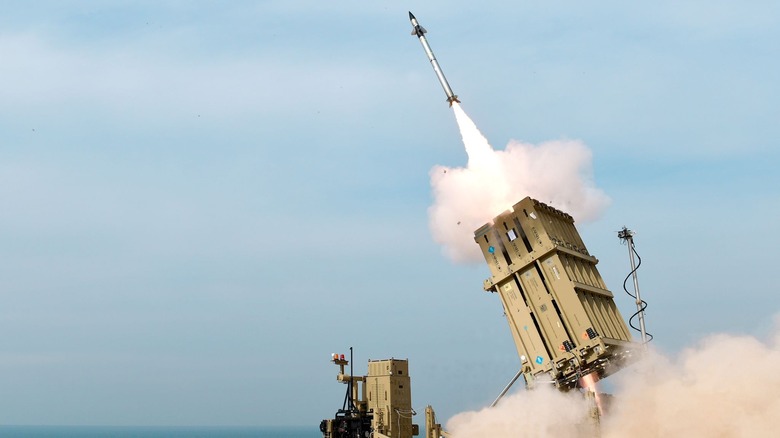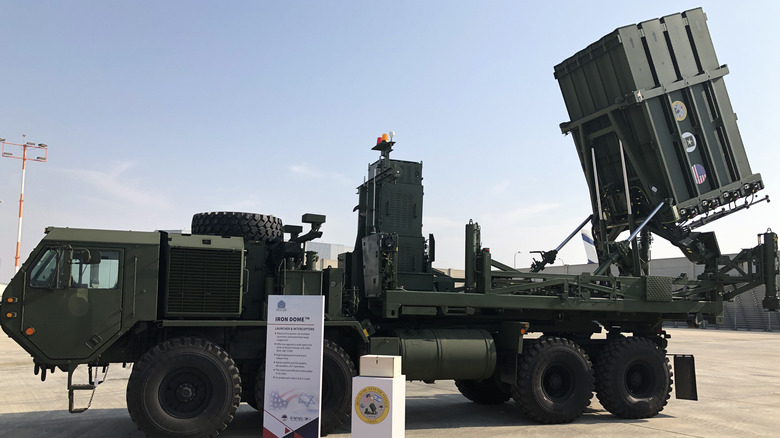Israel's Iron Dome Missile System: How Does It Work?
Touted to be one of the most effective defense systems in the world, Israel's Iron Dome has been intercepting enemy missiles and other aerial attack vectors for over a decade. Developed in collaboration with Israeli defense tech vendor Rafael and Israel Aerospace Industries, the system was first deployed in 2011, and has since reportedly been sold to a handful of Israel's geopolitical allies.
To describe it in the most fundamental terms, it's a short-range anti-mortar, anti-rocket, and anti-artillery system that also happens to be the fastest and most accurate setup of its kind at what it does. According to Israel's defense division, the Iron Dome was able to intercept as many as 97% of missiles fired at its territory, as of 2022.
Iron Dome working over Tel Aviv after rocket barrages pic.twitter.com/bGHlf9jr7u
— ELINT News (@ELINTNews) May 11, 2021
As per documents obtained via the Congressional Research Service, the U.S. government also contributed financially — to the tune of $3 billion — and technically to Iron Dome's development in the name of "U.S. Foreign Aid to Israel." American defense tech firm Raytheon Technologies Corp also played an active role in the development. The U.S. itself has purchased the Iron Dome tech from Israel, but deployment was later nixed.
At the heart of the Iron Dome's defense capabilities is the Tamir Interceptor, while the two other critical components are the battle management and weapon control system (BMC) and the ELM 2084 Multimission Radar (MMR). According to Raytheon, the system is effective round the clock and can be deployed "in all weather conditions including low clouds, rain, dust storms, and fog."
How the interception works?
Even though the Tamir interceptor is its primary defense projectile, the system comes armed with a "a first-of-its-kind multi-mission launcher" that can launch different types of interceptor missiles. The Tamir interceptor — a majority of whose components are sourced from Raytheon in the U.S. — features proximity fuze blast warheads steered via fins and electro-optical sensors.
Rafael says it can intercept "C-RAM, Cruise Missiles, Precise Guided Missiles (PGM), UAVs, Air Breathing Threats (ABTs) and dense salvos." Tamir can be fired from both mobile points — like a truck — and ground-based launch spots. While the hardware has remained more or less the same, the software powering the system is claimed to have "made tremendous leaps."
The Tamir interceptor can destroy enemy missiles that come as close as 4 kilometers, and as far away as 70 kilometers. Raytheon says a total of ten batteries have been deployed in Israel. One battery features four launchers and 20 Tamir interceptors in total. Each battery is capable of defending an area of 60 square miles, and they are mounted strategically alongside the city's defense lines to counter threats.
Rafael claims that the system has a success rate higher than 90%, however, some reports claim that the Iron Dome's efficacy falls between 80% and 90%. Its maker also notes that the defense system has amassed over 5,000 interceptions, but it's unclear how recent those figures are. Notably, the Iron Dome only neutralizes threats headed towards strategically important spots or areas with civilian presence.
Why it is highly vaunted?
Tamir is configured to avoid rockets that are heading toward uninhabited regions. This is also a key part of why the Iron Dome's overall costs are significantly lower than other defense systems. The Iron Dome uses a sophisticated radar array to detect when enemy artillery is detected, and once it algorithmically calculates that it is headed towards strategically sensitive areas, an interceptor is fired within seconds.
"This ability to discriminate contributed to an estimated exchange ratio of one interceptor fired for every three rockets fired at Israel," says a paper co-authored Peter Dombrowski, a professor of strategy at the Naval War College. These rockets then rely on infrared imaging to lock the target and destroy it mid-air. According to The Guardian, each interceptor rocket costs around $100,000, but some estimates put the final cost at half that value. According to Justin Bronk, a research fellow at the Royal United Services for Defence and Security Studies, the cost of each Tamir Interceptor could go as low as $40,000.
These aren't fireworks.
They are rockets being fired from Gaza into southern Israel.
Thank God for the Iron Dome. pic.twitter.com/Hq6SC2GQbE
— Israel ישראל 🇮🇱 (@Israel) May 10, 2023
As per the National Interest, Israel has plans to deploy five more Iron Dome batteries in the coming years. While the Iron Dome is focused on short-range interceptions, Israel has also developed versions for medium and long-range defense called David's Sling and Arrow, respectively. Israel continues to hold the proprietary rights over its Iron Dome tech, but a few years into the collaboration with the U.S. government, it agreed to share it with the U.S. in 2014.
Does the U.S. have an answer to Israel's Iron Done?
Raytheon and Rafael formed a joint venture to create a version for the US, in which the Tamir interceptor was renamed SkyHunter. It can be integrated into the U.S. Army's Multi-Mission Launcher (MML) and other V-SHORAD systems. Notably, Raytheon manufactures parts for the American SkyHunter interceptors, while assembly happens in Israel.
In 2019, Jewish Policy Center reported that the U.S. Army was planning to purchase two Iron Dome systems from Israel, after testing them against drones and finding that they met the defense wing's tactical expectations. The second battery was delivered to the U.S. in 2021. Cost considerations played a big role in the procurement.
While the cost of U.S. Patriot intercept missiles (PAC-3) runs into billions, the U.S. government only spent $373 million for its Iron Dome procurement. But due to security and compatibility concerns, the army decided to not integrate the two units into its defense architecture despite successful tests in 2022. Ultimately, the U.S. Army picked Dynetics' Enduring Shield system over the Iron Dome in 2021 to boost its "Indirect Fires Protection Capability."
In January 2023, the U.S. Marine Corps greenlit the development of a mobile defense system partly based on the Iron Dome tech as part of its Medium-Range Intercept Capability (MRIC) program. The first battery is expected to become operational in 2025, while the complete order of arming three Marine Air Wings each with an MRIC battery is expected to wrap up by 2028.



